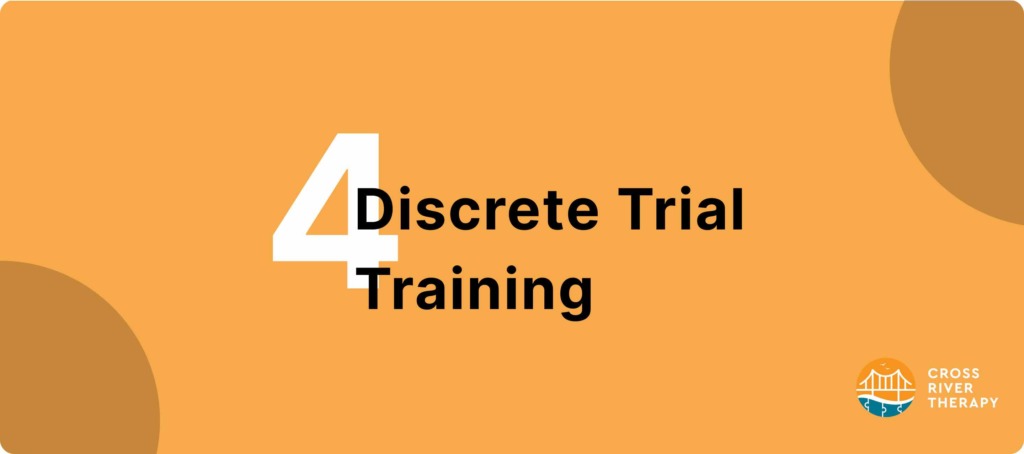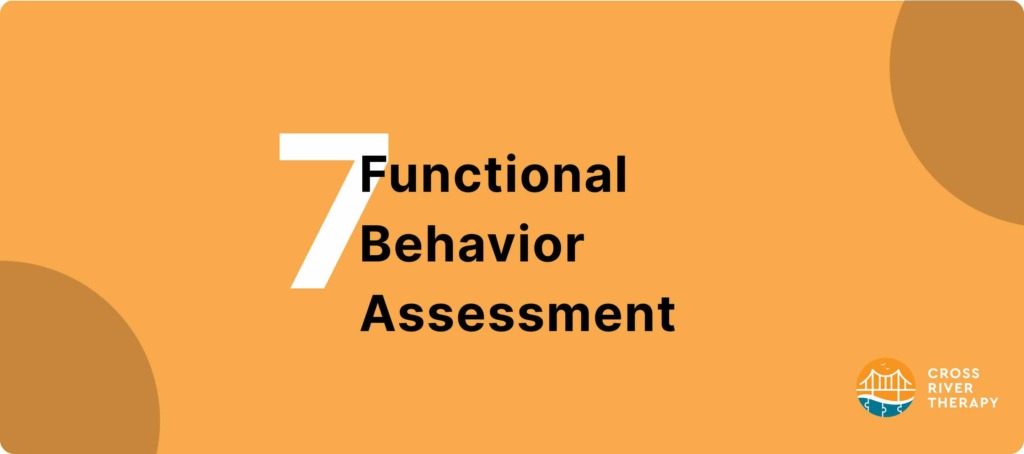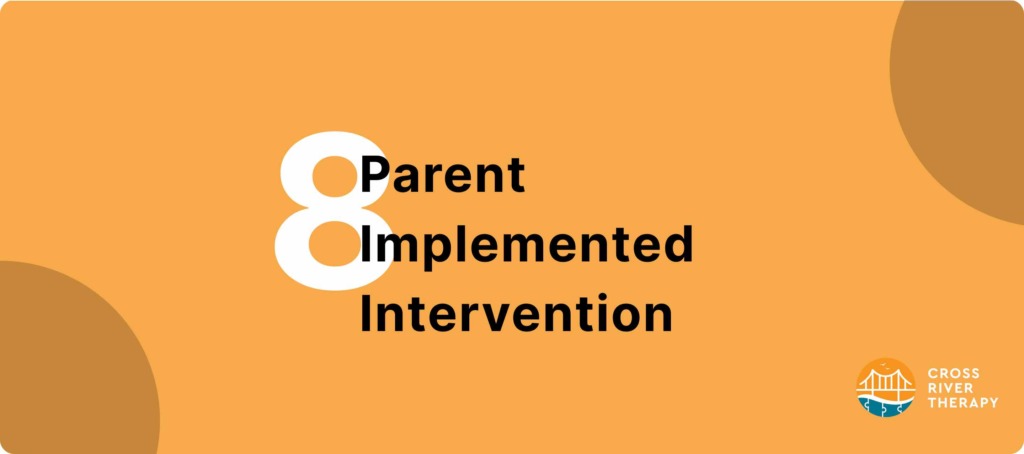12 ABA Therapy Techniques & Examples For Autism
Here are the top ABA therapy techniques and examples that are important to know for parents and therapists.

Does Your Child Have Autism?
CrossRiverTherapy is a modern provider of at-home Applied Behavior Analysis (ABA). Our best-in-class therapists are ready to help.
Here are useful ABA therapy techniques you can use to help patients.
If you’re looking for the most impactful ABA therapy techniques/examples you can use as a therapist or parent, then keep reading.
In this guide, we’ll cover ABA therapy techniques and examples that professional therapists use to help kids with autism learn and grow.
Read on!
12 Examples & Techniques You Can Use
- Positive Reinforcement
- Negative Reinforcement
- Generalization
- Discrete Trial Training
- Exercise
- Extinction
- Functional Behavior Assessment
- Parent-Implemented Intervention
- Scripting
- Redirection
- Video Modeling
- Errorless Teaching
1. Positive Reinforcement

As a basic definition, positive reinforcement is giving someone, in the case of a child with autism, praise or reward for accomplishing something that’s encouraged to do.
This is so they will continue to behave identically in the future.
Either the reward or praise should be given to the child immediately after they make the effort to behave well.
If done this way, the child will eventually learn that the positive reinforcement was given because of what they did well.
For some, this can take a while to show, but most kids catch on very fast. They’ll make efforts to act the same way. It’s a simple but very effective approach to reducing ASD symptoms.
One example of positive reinforcement involves a child that’s told to put away their toys after playtime is over.
If they do so after repeated attempts to show them the reward that they’ll receive following it, they could improve to the degree that a reward is no longer needed for them to do what they’ve been taught is the right behavior to exhibit.
However, positive reinforcement cannot be rushed.
It’s one reason why ABA therapy for some patients can last for much longer than parents anticipate.
An ABA therapist that’s assigned to work with a parent’s child will help determine the best way to engage with them using positive reinforcement.
Again, this is done right after they achieve the behavior the therapist wants from them.
Some of the behavior they want can be very basic requests, like having them look people in the eyes or getting them to say a word or series of words.
Another example involves a therapist encouraging a child to ask for things that they want instead of taking them.
When this is done, it will be given to them as quickly as possible. This is the motivator that drives them to continue to engage in requests to get what they want.
Read More: Positive vs. Negative Punishment
2. Negative Reinforcement

On many occasions, children with ASD won’t behave the way that parents would like them to. In instances like this, the behavior must be mitigated right away.
Punishing a child is fine, so long as it’s done to show them how negative the behavior is to them and everyone nearby.
Punishments should be consistent but never harsh.
A simple takeaway of certain items they might want, such as a toy for a while, may elicit better behavior from them at a later time.
Tantrums are a known symptom of autism and can be the result of parents not partaking in negative reinforcement with their child.
ABA therapy is a well-researched way to take away the most severe reactions that are caused by autism.
Below are descriptions of the aggressive spells that are related to autism, along with how they can be prevented or reduced in frequency.
The CDC describes tantrums as the most typical symptom of autism.
It’s very prevalent in kids that haven’t undergone treatment for the disorder.
About one out of every four autistic children lists anger and aggression as common symptoms. Outbursts are also very common and frequent.
Boys usually show more aggression than girls, yet the number of outbursts can be about the same.
Overall, aggression can be present in anyone with autism, regardless of their age, sex, or level of experience in therapy.
Kids that have difficulty engaging in social activities and engage in repeat behavior are likely to have aggressive spells.
Over time, this aggression can lead to long-term problems with their learning abilities, at school and home.
Self-harm may be a problem that comes along with it, including harm to other children.
Their aggressiveness might be targeted at guardians or even teachers, people that they don’t intentionally mean to hurt, but do so out of not knowing how to express themselves beyond a tantrum.
3. Generalization

Generalization is useful for getting autistic children to learn.
The therapist will examine things that a child has been taught already and use them for other areas in their therapy sessions.
For instance, a kid with ASD might be familiar with the alphabet and can sing it without missing a note or letter.
Taking advantage of this familiarization, the therapist could apply singing of the alphabet song to other areas, such as getting them to recite their name but in a way that sounds like a song.
4. Discrete Trial Training

Discrete trial training is used during ABA therapy, an important strategy for compartmentalizing skills to give them a smaller, more discrete element.
Therapists show these elements to the children they work with, though not at the same time.
When they provide the therapist with the right response to the element, they are rewarded with positive reinforcement. This pattern continues every time they give the appropriate response.
When a therapist is getting a child to become aware of their emotions, they might divide them into individual pieces. More specifically, broken down into different lessons.
This helps them to set the emotions they learn about apart from one another. It’s done through identification.
One emotion for them to identify could be happiness by looking at varied photographs that display kids exhibiting more than one type of emotion.
The therapist would ask them to point to the photos that express them in a happy state.
When they correctly point to a photo, they’re met with positive reinforcement and praise, either verbally or through a tangible reward.
After a child can identify happy expressions, therapists then progress to other emotions.
And when those are all learned, other steps using the discrete trial training method can be done, for as long as they remain in therapy.
5. Exercise

Exercise is used to help therapists connect with the children they teach.
It’s great for getting them into physical activities that are good for their health.
Exercise has numerous benefits for treating all people with ASD, not just kids. Some of these are as follows:
- Increase mood lift – Exercise helps autistic kids release the energy they have positively, instead of letting it condense into a potential tantrum. It gives them something to occupy their time and could even help them with rest when having trouble getting to sleep at night.
- Place them in a relaxed state – With routine exercise, people learn to focus their energy better on things needed from them, even when the workout is over. The ability to focus on what instructors and therapists wish for a child to complete in therapy is very important, and exercise is one step in getting them to behave in this way.
- Good for learning verbal and social skills – Exercise is an instructional activity that can only be successfully done when the people engaged in it can communicate through body language and verbal commands. This can follow into other tasks where positive reinforcement is the wanted goal.
- Improves memory – Exercise helps to awaken the body and the senses, making kids more alert and willing to respond to commands given to them.
When using exercise, it doesn’t have to be something too demanding, such as push-ups or sit-ups. Exercise can take the form of a game with a ball, or with different stretching techniques.
The exercises can be performed at specified times of the day, during breaks in between therapy sessions in an indoor or outdoor area.
6. Extinction

Extinction can be thought of as the opposite of positive reinforcement, or at least the technique used when certain behavior is exhibited.
It’s when reinforcement is cut off during instances of behavior that arise, such as loudness or excessive jumping and moving when a child anticipates a reward.
Extinction is distinguished from punishment since a reward can be given, but not as quickly as they would receive it from positive reinforcement.
7. Functional Behavior Assessment

ABA therapists use functional behavior assessment to pinpoint behaviors that should be changed to keep an autistic child learning.
It’s beneficial to therapists that need information on the characteristics of certain behaviors, helping them to figure out why they manifest and if any factors are contributing to them doing so. It’s a fundamental assessment for interventions attempted by therapists.
8. Parent-Implemented Intervention

The most successful ABA treatment happens when parents collaborate with therapists. Parent implemented intervention helps foster communication and successful behavior changes for the better.
Therapists train parents on the principles of ABA therapy and how they can use it on their child, regardless if it’s needed long after therapy has ended for them.
Parents informed about ABA can produce good outcomes for children with ASD at a fast pace.
9. Scripting

Therapists use scripting when the same words are repeated many times.
It helps the children they teach learn skills quicker this way. First, the therapist develops a circumstance where the child must work with a script.
Usually, the script is a directive, telling the child to do something as simple as looking at someone, moving an object, or putting something away.
10. Redirection

The redirection technique can be applied by ABA therapists, parents of autistic kids, or their ordinary teachers at school.
It’s when a child is intentionally distracted when they engage in poor behavior.
Instead of letting an unwanted situation grow into a tantrum or self-harm, redirection helps them move on to something that can draw them away from it and behave well again.
11. Video Modeling

Modeling is easy for parents and their child’s therapists to do. It doesn’t involve anything special besides an idea of how they wish a child to behave in a situation.
As the name indicates, someone is partaking in an activity that the child must do.
Seeing someone engaged and focused on the behavior being modeled can motivate them to try it out.
For added effect, more than one person can practice video modeling, even turning it into a fun activity.
12. Errorless Teaching

As an antecedent, errorless teaching lowers the chances of children giving the wrong response when they’re presented with a question or demand.
To help with this, children are provided cues that are visual, physical, or verbal.
As a hypothetical example, a child that’s asked to find a toy, with the therapist showing them picking up a copy of the same toy in a way that must be mimicked by the child.
When they respond by picking it up the same as they did, it takes away the error in getting them to carry out requests.
Who Benefits The Most From ABA Therapy Techniques?
ABA therapy benefits the most autistic children that haven’t begun or are in the first years of school. It’s also great for people that don’t have autism.
Parents that have children diagnosed with Asperger’s syndrome may seek ABA therapy to help them become more sociable and engaged with their peers.
Kids with deficiencies in their emotional, behavioral, and cognitive development come out of ABA therapy with improvements.
All names can be a part of or closely related to autism or other spectrum disorders.
What To Keep In Mind
Autism, also abbreviated as ASD, is a disorder that can cause developmental issues.
It can also impact how kids socialize and talk. Some people with autism, kids, especially, have issues communicating.
Autism is referred to as a spectrum disorder since kids can be found anywhere, in any situation.
Kids with ASD begin showing common symptoms of autism when they’re very young.
These can prolong well past their childhood and even last late into their adult life.
Many health professionals don’t fully understand why some kids show signs of autism, or how it comes about in the patients they see.
It’s thought of as a mixture of genetic traits passed down from parents to themselves.
Environmental factors might also be significant in the development of autism. Many autistic kids exhibit problems with understanding other people or relating to them.
Eye contact can be very difficult. they may fall into their world and become withdrawn or disillusioned from the environment around them.
As a result of this, many with ASD will appear disinterested in things that other kids may find amusing or intriguing.
Such disassociation might appear when in the company of relatives that come over or when people are in the presence of a child that they don’t know well.
References
- Regiscollege.edu
- University Of Kansas
- Ncbi.nlm.nih.gov
- Regis College
- Appliedbehavioranalysisprograms.com

Have Any Questions?
Whether you're curious about our services or need support, we're just a click away. Reach out or check our FAQs for quick answers.

